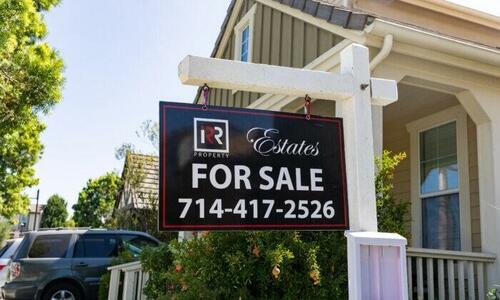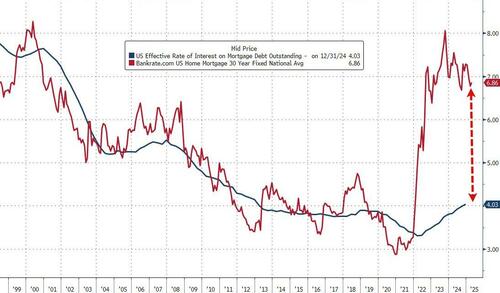Authored by Naveen Athrappully via The Epoch Times,
The homeownership rate in the United States declined to 65.1 percent in the first quarter of this year, 0.6 percentage points lower than in the previous quarter, the U.S. Census Bureau said in a statement on April 28.
“This quarter’s homeownership rate is the lowest since Q4 of 2019,” real estate listings website Realtor said in an April 28 report.
“The homeownership rate spiked in early 2020 before settling in the mid 65% – 66% range through the pandemic and the years following.”
Realtor attributed the decline in homeownership rate in the first quarter to a lack of affordable housing.
“Though inventory levels continue to rise on an annual basis, the number of homes for sale is still below pre-pandemic levels, which has kept upward pressure on home prices and limited affordable options for many households,” it said.
The homeowner vacancy rate, which is the proportion of properties owned that are vacant and for sale, was 1.1 percent higher than in the first quarter of 2024 but remained the same in the fourth quarter of 2024. This was higher in major cities compared to the suburbs. The vacancy rate was the lowest in the Northwest and highest in the West.
According to Realtor, vacancy rates had remained below the 1 percent level from the first quarter of 2022 to the third quarter of 2024, which emphasized “the lack of for-sale inventory,” it said.
“Though recent inventory gains have kept vacancy at a recent high, there are still far fewer vacant homes than was typical in the years pre-pandemic, suggesting that inventory still has some ground to cover,” it said.
Overall, roughly 89.5 percent of all housing units in the United States were occupied in the first quarter of this year, with the properties occupied by either homeowners or renters, the bureau said.
In a Feb. 10 report, JP Morgan said the lower vacancy rates suggest potential supply constraints in the market.
“Vacancies indicate that there are enough homes available, but these may not be the right type, in the ideal location, or at an affordable price point,” it said, adding that the housing market demand was “seriously suppressed” by elevated interest rates.
The weekly average rate on a 30-year fixed-rate mortgage has remained above 6.5 percent for the entire first quarter of this year, according to data from Freddie Mac.
The elevated rates make mortgage payments more expensive, thus deterring prospective buyers seeking affordable homes.
John Sim, head of securitized products research at JP Morgan, said the housing market situation “is not going to change until we get mortgage rates back down toward 5 percent, or even lower.”
“And we aren’t forecasting mortgage rates to breach 6 percent in 2025—they should ease only slightly to 6.7 percent by the year-end,” Sim said in a statement.
Easing Housing Conditions
There are signs that housing costs are cooling down as home prices fall. In the four weeks ending April 20, the median sales price of homes fell year over year in 11 out of the 50 populous metros in the United States, real estate brokerage Redfin said in an April 24 statement.
“Home prices are falling in many major metros—and price growth is decelerating nationally—because many house hunters are backing off, but the number of homes for sale is holding up,” the brokerage said.
“Home tours are slowing, mortgage-purchase applications are falling, and Redfin agents in many parts of the country report that would-be buyers are ultra-cautious amid high housing costs and widespread economic uncertainty.”
Chen Zhao, Redfin’s economic research lead, advised sellers to price their homes “fairly.” Sellers may have to lower their asking prices in order to “sell quickly and avoid giving concessions,” he added.
As for mortgage rates, Sam Khater, chief economist at Freddie Mac, highlighted in an April 24 statement that the 30-year fixed-rate mortgage rate has fluctuated by less than 20 basis points over the past couple of months.
This stability bodes “well for buyers and sellers alike,” he said.
Meanwhile, a bipartisan group of lawmakers reintroduced the Rural Housing Service Reform Act this month, aimed at strengthening the supply of affordable housing in rural communities and small towns, according to an April 3 statement from the office of Sen. Tina Smith (D-Minn.).
The Act proposes several key measures, including requiring the Department of Agriculture to expedite the loan approval process and updating rules for home repair loan programs to make it less burdensome to obtain smaller loans.
“Improving homeownership opportunities, particularly in rural areas, is critical for the well-being of South Dakota families,” Sen. Mike Rounds (R-S.D.), one of the lawmakers who introduced the bill, said in a statement.
The Act “would streamline federal programs and remove barriers to homeownership, making this dream a reality for more South Dakotans. It would also preserve existing affordable housing and rental assistance in rural areas,” he said.
Loading…



















